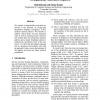Free Online Productivity Tools
i2Speak
i2Symbol
i2OCR
iTex2Img
iWeb2Print
iWeb2Shot
i2Type
iPdf2Split
iPdf2Merge
i2Bopomofo
i2Arabic
i2Style
i2Image
i2PDF
iLatex2Rtf
Sci2ools
BMCBI
2008
2008
Recognizing speculative language in biomedical research articles: a linguistically motivated perspective
We explore a linguistically motivated approach to the problem of recognizing speculative language ("hedging") in biomedical research articles. We describe a method, which draws on prior linguistic work as well as existing lexical resources and extends them by introducing syntactic patterns and a simple weighting scheme to estimate the speculation level of the sentences. We show that speculative language can be recognized successfully with such an approach, discuss some shortcomings of the method and point out future research possibilities.
| Added | 09 Dec 2010 |
| Updated | 09 Dec 2010 |
| Type | Journal |
| Year | 2008 |
| Where | BMCBI |
| Authors | Halil Kilicoglu, Sabine Bergler |
Comments (0)

